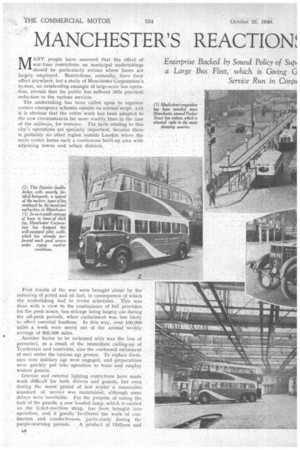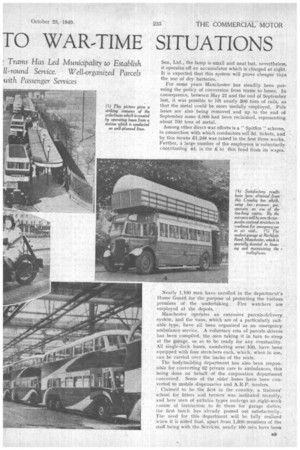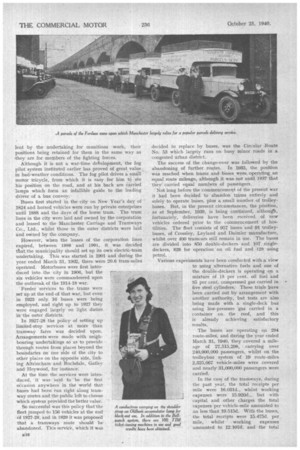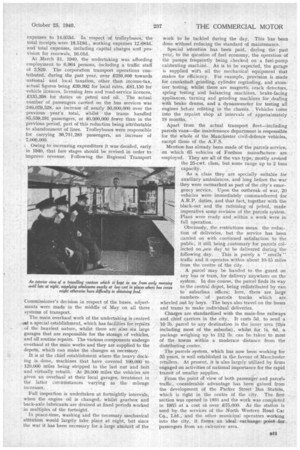MANCHESTER'S REACTION ,
Page 26

Page 27

Page 28

Page 29

If you've noticed an error in this article please click here to report it so we can fix it.
TO WAR-TIME SITUATIONS
MANY people have assumed that the effect of war-time. restrictions on municipal undertakings should be particularly serious where buses are largely employed. Restrictions, naturally, have their effect anywhere, but a study of Manchester Corporation's system, an outstanding example of large-scale bus operation, reveals that the public has suffered little practical reduction in the various services.
The _undertaking has been called upon to organize certain emergency schemes outside its normal scope, and it is obvious that the entire work has been adapted to the new circumstances far more readily than in the case of the railways, for instance. The facts relating to this city's operations are specially, important, because there is probably no other. region outside London where the main centre forms such a continuous built-up area with adjoining towns and urban districts, ,
FirSt results of the war were brought about by the rationing Of petrol and oil fuel, in consequence of which the undertaking had to revise schedules. this was done with a view to the continuance of full provision for.the,peak notirs, bus mileage being largely cut during the off-peak -periods, when curtailment was less likely to affect essential busffiess. In this way, over 100,000 mile week Week Were saved out of the normal weekly average of 602,000 miles.
, Another factor to be reckoned with was the loss of personnel, as a result of the immediate calling-up of Territorials and reservists, also the continued enlistment of men under the various age groups. To replace them, men over military age were engaged, and preparations were quickly put into operation to train and employ women guards.
Interior. and exterior lighting restrictions have made work difficult for both drivers and guards, but even 'during the worst period of last winter a reasonable standard of service Was maintained, although some delays were inevitable, For the purpOse of easing the , task of the guards, a new hooded lamp, which is carried on the ticket-machine strap. has been brought into Operation-, and it greatly -faCilitatei the work of conductors and conductresses, particularly during the
purple warningperiods. A product of Oldham and Son, Ltd., the lamp is small and neat but, nevertheless, it operates off an accumulator which is charged at night. It is expected that this system will prove cheaper than the use of dry batteries.
For some years Manchester has steadily been pursuing the policy of conversion from trams to buses. In consequence, between May 21 and the end of September last, it was possible to lift nearly 300 tons of rails, so that the metal could be more usefully employed. Pole bases are also being removed and up to the end of September some 4,000 had been reclaimed, representing about 700 tons of metal.
Among other direct war efforts is a" Spitfire " scheme, in connection with which conductors sell 3d. tickets, and by this means £1,248 was raised in the first three weeks. Further, a large number of the employees is. voluntarily. contributing 4d. in the to this fund from its wages:
Nearly 1,100 men have enrolled in the department's Home Guard for the purpose of protecting the various. premises of the undertaking. Fire watchers are • employed at the depots, Manchester operates an extensive parcels-delivery_ system, and the vans, which are of a particularly suitable type, have all been organized as an emergency ambulance service. A voluntary rota of parcels drivers has been compiled, the men taking it in turn to sleep at the garage, so as to be ready for any eventuality. All single-deck buses, numbering over 100, have been equipped with four stretchers each, which, When in use, can be carried over the backs of the seats.
The bodybuilding department has also been responsible for converting 62 private cars to ambulances, this being done on behalf of the corporation department concerned. Some of the older buses have been converted to mobile dispensaries and A.R.P. tenders.
Claimed to be the first in the country, a trainees' school for fitters and turners was instituted recently, and here men of suitable types undergo an eight-week course of instruction to fit them for garage duties; the first batch has already passed out satisfactorily. The need for this department will be fully realized when it is noted that, apart from 1,300 members of the staff being with the Services, nearly too men have been lent by the undertaking for munitions work, their positions being retained for them in the same way as they are for members of the fighting forces.
Although it is not a war-time detelopment, the fog pilot system instituted earlier has proved of great value
In bad-weather conditions. The fog pilot drives a small motor tricycle, from which it is easy for him to -see his position on the road, and at his back are carried lamps which form an infallible guide to the leading driver of a bus convoy.
Buses first started in the city on New Year's day of 1824 and horsed vehicles were run by private enterprises until 1888 and the days of the horse tram. The train lines in the city were laid and owned by the corporation and leased to the Manchester Carriage and Tramways Co., Ltd., whilst those in the outer districts were laid and owned by the company.
However, when the leases of the corporation lines expired, between 1898 and 1301, it was decided
ttat the municipality should set up its own electric-tram undertaking. This was started in 1901 and during the year ended March 31, 1902, there were 20.6 tram-miles operated. Motorbuses were first introduced into the city hi 1906, but the six vehicles were commandeered upon the outbreak of the 1914-18 war.
' Feeder services to the. trams were ,set up at the end of that war, but even in 1923 only, 16 buses were being employed, and right up to 1927 they were engaged largely on light duties in' the outer districts.
In 1927-28 the policy of setting up limited-stop services at more than tramway fares was decided upon. Arrangements were made with neighbouring undertakings so as to provide through routes from places beyond the boundaries on one side of the city to other places on the opposite side, linking Altrincham and Rochdale, Gatley and Heywood, for instance.
At the time the services were introduced, it was said to be the first occasion anywhere in the world that buses had been run right along tramway routes and the public left to choose 'which system provided the better value.
So successful was this policy that the fleet jumped to 156 vehicles at the end
• of 1927-28; and in 1929 it was proposed that a tramways route should be abandoned. This service, which it was
decided to replace by buses, was the Circular Route No. 53 which largely runs on busy minor roads in a congested urban district. _ The success of the change-over was followed by the abandoning of further routes. In 1933, the position was reached when trams and buses were operating an equal route mileage, although it was not until 1937 that they' carried equal numbers of passengers.
Not long before the commencement of the present war it had been decided to abandon trams entirely and solely to operate buses, plus a small number of trolley. buses. But, in the present circumstances, the position, as at September, 1939, is being continued, althouri, fortunately, deliveries have been received of new vehicles ordered prior to the commencement of hostilities. The fleet consists of 957 buses and 91 trolleybuses, of Crossley. Leyland and Daimler manufacture, whilst over 400 tramcars still remain in use. The buses are divided into 850 double-deckers and 107 singledeckers, 828 for operation on oil fuel and 129 using petrol.
Various experiments have been conducted with a view to using alternative fuels and one of the double-deckers is operating on a mixture of 15 per cent. oil fuel and 85 per cent. compressed gas carried in • five steel cylinders. These trials to,ve been carried out by arrangement with another authority, but tests are also being made with a single-deck bus using low-pressure 'gas carried in a container on the roof, and this is already achieving satisfactory results.
The buses are operating on 294 route-miles, and during the year ended March 31, 1940, they covered a mileage of 27,515,298, carrying over 240,000,000 passengers, whilst on the trolleybus system of 19 route-miles 2,325,067 vehicle-miles were covered and nearly 31,000,000 passengers were carried.
In the case of the tramways, during the past year, the total receipts per mile were 16.031d., whilst working expenses were 15.920d., but with capital and other charges the total expenses per vehicle-mile amounted to no less than 19.515d. With the buses, the total receipts were 15.475d. per mile, whilst working expenses amounted to 12.107d. and the total expenses to 14.053d. In respect of trolleybuses, the total receipts were 18.518d., working expenses 12.684d. and total expenses, including capital charges and provision for renewals, 16.01d.
At March 31, 1940, the undertaking was affording employment to 6,964 persons, including a traffic staff of 3,29. The corporation transport operations contributed, during the past year, over 2250,000 towards national and local taxation, other than income-tax, actual figures being 239,992 for local rates, £81,150 for vehicle licences, licensing fees and road-service licences, 2135,398 for duties on petrol and oil. The actual number of passengers carried on the bus services was 240,079,528, an increase of nearly 30,000,000 over the previous year's total, whilst the trams handled 85,559,191 passengers, or 40.000,000 fewer than in the previous period, part of this reduction being attributable to abandonment of lines. Trolleybuses were responsible for carrying 30,751,283 passengers, an increase of 7,000,000.
Owing to increasing expenditure it was-decided, early in 1940, that fare stages should be revised in order to improve revenue. Following the Regional Transport
Commissioner's decision in respect of the buses, adjustments were made in the middle of May on all three systems of transport.
The main overhaul work of the undertaking is centred ost a special establishment, which has facilities for repairs of the heaviest nature, whilst there are also six large garages that are responsible for the storage of vehicles, and all routine repairs. The various components undergo overhaul at the main works and they are supplied to the depots, which can make the changes as necessary.
... It is at the chief establishment where the heavy docking is done, machines that have covered 100,000 to 120,000 miles being stripped to the last nut and bolt and virtually rebuilt. At 20,000 miles the vehicles are given an overhaul at their local garages, treatment in the latter circumstances varying as the mileage increases.
Full inspection is undertaken at fortnightly intervals, when the engine oil is changed, whilst gearbox and back-axle lubricants are drained at fixed periods worked in multiples of the fortnight.
1 In peace-time, washing and the necessary mechanical attention would largely take place at night, but since the war it has been necessary for a large amount of the work to be tackled during the day. This has been done without reducing the standard of maintenance..
Special attention has been paid, during the past year, to the question of fuel economy, the operation of the pumps frequently being checked on a fuel-pump calibrating machine. As is to be expected, the garage is supplied with all the mechanical equipment that makes for efficiency. For example, provision is made
for crankshaft grinding, cylinder regrinding, and atomizer testing, whilst there are magnetic crack detectors,
spring testing and balancing machines, brake-facing appliances, turning and grinding machines for dealing with brake drums, and a dynamometer for testing all engines _before refitting in the chassis. Vehicles come into the repaint shop at intervals of approximately 18 months.
Apart from the actual transport fleet—including parcels vans—the maintenance department is responsible for the whole of the Manchester civil-defence vehicles, except those of the A.F.S.
Mention has already, been made of the parcels service, on which 65 vehicles of Fordson manufacture are employed. They are 411 of the van type, mostly arohnd the 25-cwt. class, but some range up to 2 tons capacity.
As a class they are specially suitable for auxiliary ambulances, and long before the war they were earmarked as part of the city's emer gency service. Upon the outbreak of war, 20 vehicles were immediately commandeered for A.R.P. duties, and that fact, together with the black-out and the rationing of petrol, made imperative some revision of the parcels system. Plans were ready and within a week .vere in full operation.
Obviously, the restrictions mean. the reduc tion of deliveries, but the service has been carried on with continued satisfaction to the
public, it-still being customary forparcels collected on ,„one day to be delivered during the
following day. This is purely a " smalls " traffic and it operates within about 10-15 miles from the centre of the city.
. A parcel"may be handed to the guard on any bus or tram, for delivery anywhere on thern system. In due course, the parcel finds its way to the central depot, being redistributed by van to suburban offices; here, there are large numbers of parcels trucks which are wheeled but by boys. .The boys also travel on the buses and trams to make individual deliveries, Charges are standardized with the main-line railways and chief carriers in the city. It costs 5d, to send a
10 lb. parcel to any destination in the inner area (this including most of the suburbs), whilst for, Is. 6d. a package weighing up to 112 lb. can be taken to most of the towns within a moderate distance from the _distributing centre.
The parcels system, which has now been working for 35 years, is well established in the favour of Manchester
retailers. At present, it is also largely utilized by firms engaged on activities of national importance for the rapid transit of smaller supplies. •
From the point Of view of both passenger and parcels traffic, considerable advantage has been gained from the development of the Parker Street ,Bus Station, which is right in the centre of the city. The first section was opened in 1931 and the work was completed
in 1935 at a cost of over 275,000. • As the station is used by the services of the North Western Road Car Co., Ltd., and the other municipal operators working into the city, it forms an ideal exchangepaint -for . passengers from anextensive area.




















































